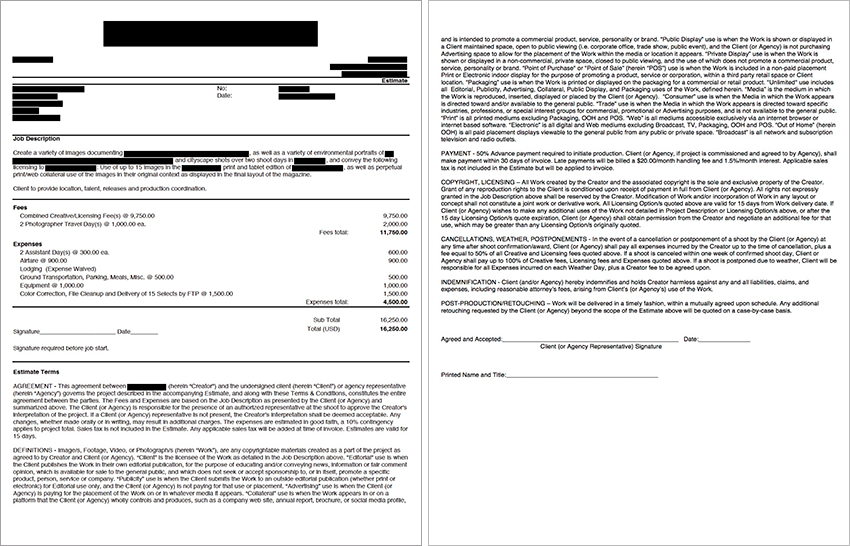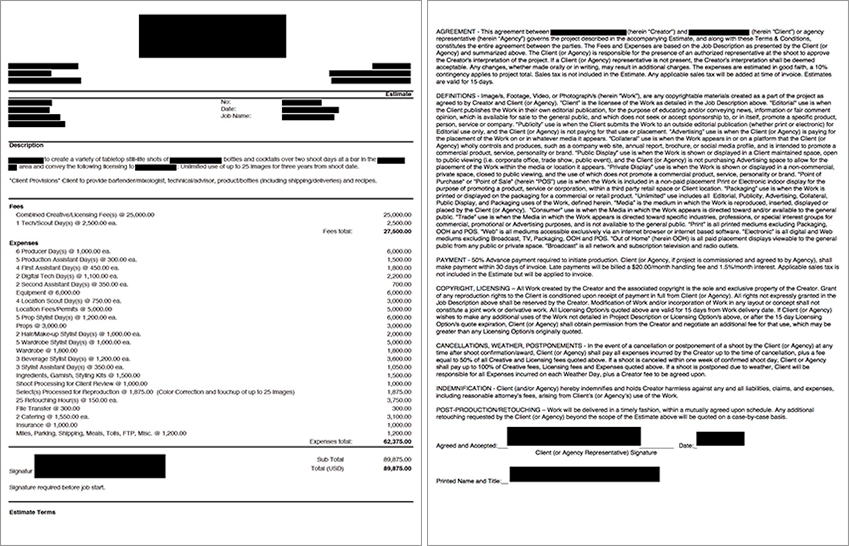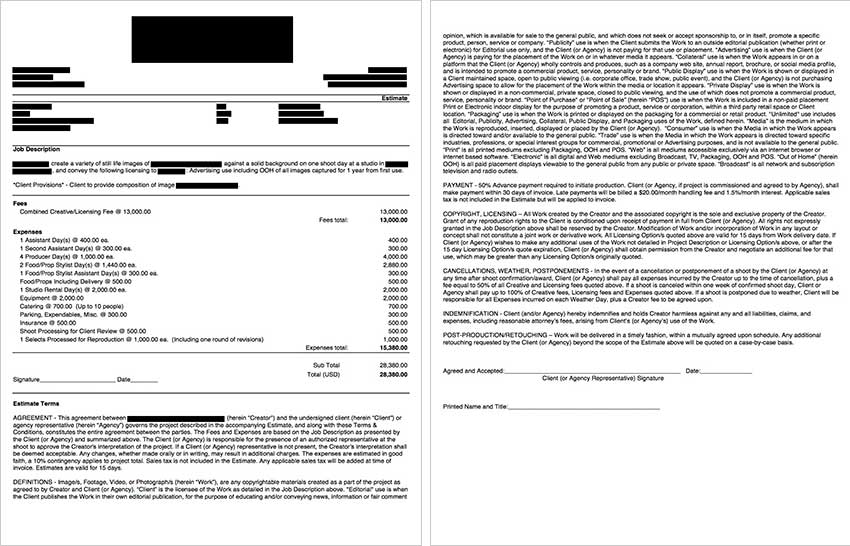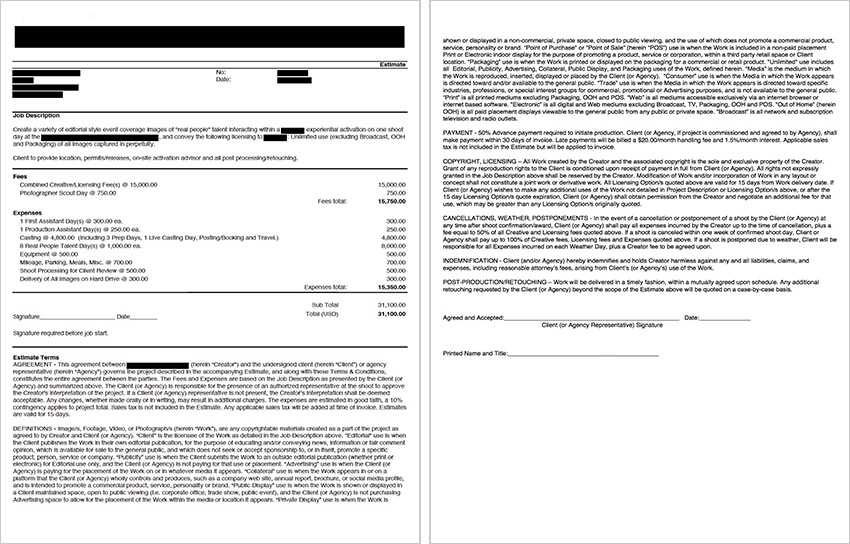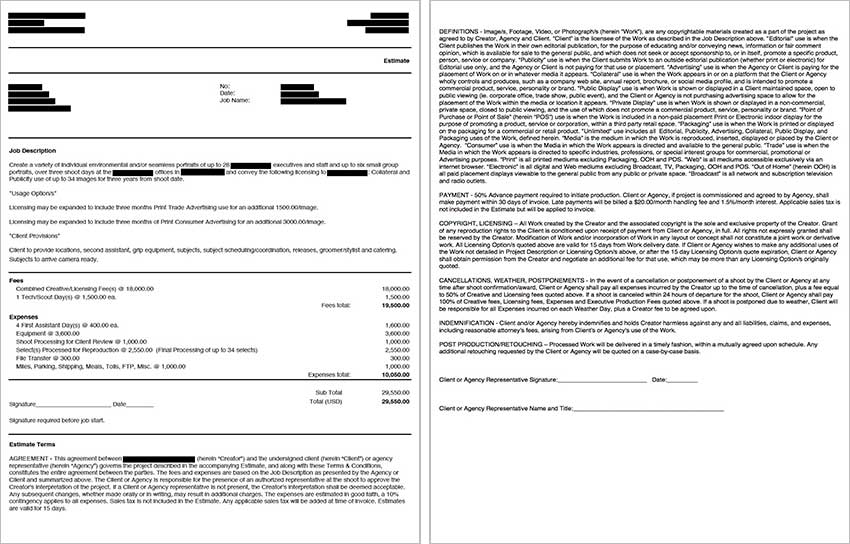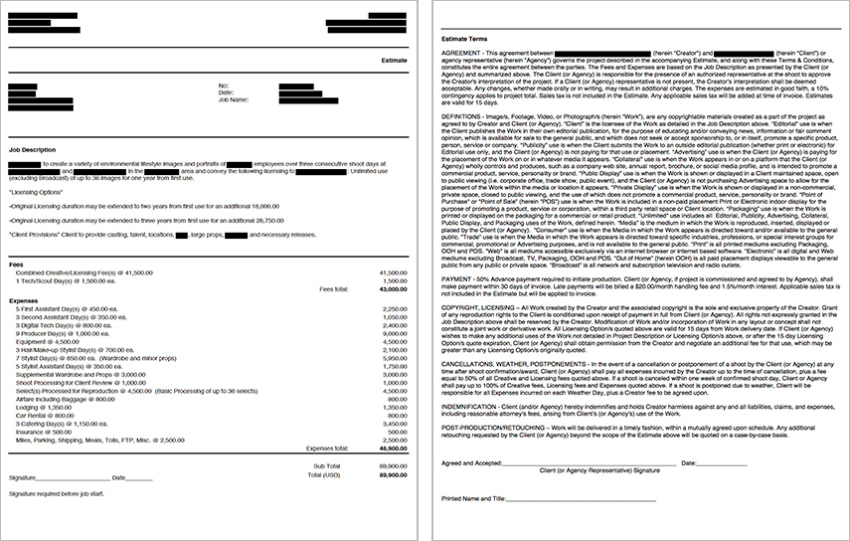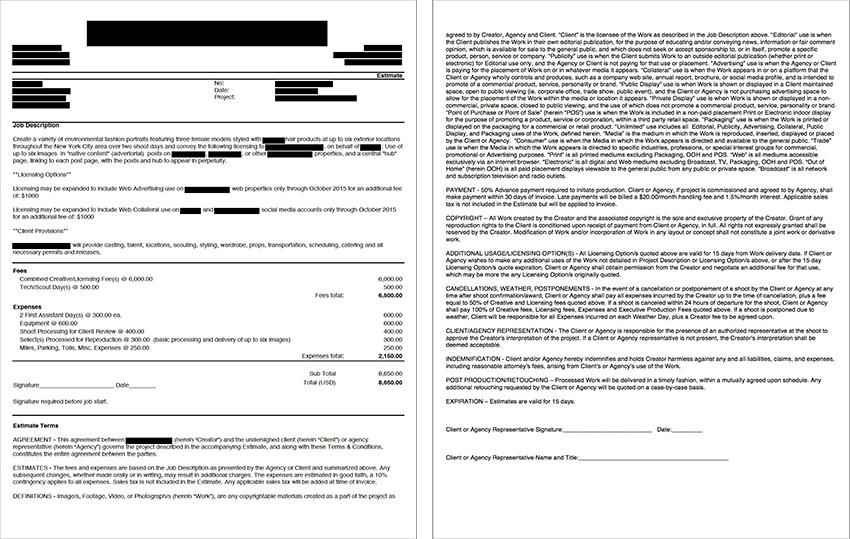Craig Oppenheimer, Wonderful Machine
Shoot Concept: Environmental lifestyle images of professional talent working and interacting in various business scenarios alongside a video production.
Licensing: Worldwide Advertising, Collateral and Publicity use of up to seven images for one year.
Location: Multiple business and retail locations in the South.
Shoot Days: 2
Photographer: Lifestyle and portraiture specialist based on the West Coast.
Agency: Medium-sized, based in the Midwest.
Client: Large, multinational technology company
Here is the estimate:

Creative/Licensing: The art producer at the agency sent a very rough shot list with limited visual references describing situations in which people were interacting and using apps on a phone to conduct business. There were seven images they hoped to capture, many of which were in different environments with unique talent. The photographer and I originally assumed the shoot would take three to four days given the uniqueness of each environment, but we found out that a video production team was arranging all of the logistics to capture video prior to shooting stills in each environment, and that they would be dictating the pace of the project.
The art producer asked us to submit an estimate reflecting a two-day shoot (which is what the video production company estimated), and since we would truly be piggy-backing our portion of the project to the video, our estimate needed to reflect this. It was possible that the information provided and discussed with the video production company was a bit different than what we were presented with, but given that they’d be responsible for the majority of the logistics and details (and since it was their responsibility to cram it all into two days), we were comfortable presenting an estimate for the photographer and his crew to tag along to capture still images of their setups.
Even though most of the images were unique, I felt it was appropriate to determine a fee for the first image, and apply a discount for the subsequent images since it was most likely that the client would only take advantage of the full licensing for just a handful of images throughout the year. I decided that the first image was worth $7,000, images 2-3 were worth $4,000 each, images 4-5 were worth $3,000 each, and images 6-7 were worth $1,500 each, totaling $24,000. The agency asked us to give them an idea of what additional images would cost, and I decided that a pro-rated fee based on 7 images and $24,000 would be most appropriate. I rounded up the pro-rated fee a bit to an even $3,500 for each additional image.
On one hand, I initially felt the fee was low since this was for a major brand capable of taking advantage of the international advertising licensing that the photographer would be granting. For instance, Getty prices international advertising use for one year closer to $13,000 per image, and Corbis prices their “All Marketing Pack” for one year closer to $17,500 for one image (although this includes broadcast use and a handful of other uses that were unlikely for this project). On the other hand, I’ve compiled many “shooting alongside video” estimates recently, and due to the stills oftentimes being an afterthought, fees have frequently landed closer to $7,000-$10,000 per day including unlimited use of the images. I felt our pricing was appropriately calculated by the image, but if you were to look at our fee by the day, $12,000 per day for two days seemed pretty healthy considering that the licensing was limited to one year.
Photographer Travel/Scout Days: This accounted for the photographer’s time to travel in, scout the following day, and then travel back after the shoot.
Assistants: Even though the video production would be providing the majority of the production elements, we wanted to make sure there were enough hands dedicated to setting up, moving and breaking down the still photo gear, so we included three assistants. The first assistant would travel to the shoot with the photographer, and both the second assistant and third assistant would be hired locally.
Digital Tech: The digital tech would also be flying in with the photographer, and we broke out the fees for their travel/scout days from their shoot days, while also lumping in a fee of $750 for a workstation on each shoot day.
Producer: Even though the video team would be wrangling most items for the project, we still included fees for a local producer to get involved and offer support for the photographer to find crew, arrange travel accommodations and be the main point of contact between the video production company, agency and the still photography team regarding logistics. I included three prep/wrap days on top of the two shoot days for the producer.
Equipment: We were a bit in the dark about what types of environments the photographer would need to light, but to be on the safe side, we estimated needing at least $2,000 worth of camera bodies, lenses, grip and other gear per day, and figured most rental houses would offer a “three days same as a week” discount to account for the shoot days and the scout day.
Airfare, Lodging, Van Rental: I used kayak.com to acquire costs for the photographer, his first assistant and digital tech to fly in, spend four nights and then fly back home after the shoot while having a large van with them for the length of the trip.
Miles, Parking, Meals, Hard Drive, Misc: I included $50 per person per day for the photographer, his assistant and digital tech to cover each day they’d be out of town. I also included $100 for each shoot day and the scout day to cover miscellaneous expenses, $200 to cover a hard drive and shipping costs and $250 to cover parking and to add a bit of a buffer for any unforeseen expenses that might arise.
After submitting our estimate, the art producer told us there was a chance the video portion of the project might be removed. This meant that all of the production elements would then be the responsibility of the still photography team, and we were asked to draft an estimate detailing all of the fees and expenses for such a scenario. As I noted earlier, a two-day shoot seemed very optimistic at the onset of the project, and after a discussion with the photographer, we decided to estimate a three-day shoot which seemed much more comfortable based on the scope of the project.
Here is the estimate:

Creative/Licensing: The licensing stayed the same, but we added a day to the shoot. In order to keep the fees palatable to the agency, we just increased the rate by $2,000 to account for the photographer’s time on the additional day. Also, they asked if we could offer a discount on the additional images and provide a pricing structure that was more affordable in case they wanted to license up to 30 total shots, rather than seven. We decided to offer five additional images at $2,500 each, and then included a discount for images 13-22 at $750 per image and images 23-30 at $350 per image.
Photographer Travel/Scout Days: Based on a discussion regarding the potential schedule, we included one day to travel in and attend a talent fit day, followed by two scout days before the shoot and a travel day after the last shoot day.
Assistants: Just as before, the photographer planned to bring his first assistant for the entire length of the trip (including the fit day and scouting) and hire two local assistants to lend a hand on each of the three shoot days.
Digital Tech: Again, the tech would also travel in with the photographer and his first assistant, and similar to the previous estimate, we broke out his travel/scout days from his shoot days.
Producer and Production Assistant: Since the scope of the logistics that would need to be coordinated drastically increased, the local producer’s workload needed to be accounted for. We included eleven days (four pre-production days, one fit day, two scout days, three shoot days and one wrap day) and also added a production assistant to lend a hand throughout the shoot and help with pre-production and scouting as needed.
Hair/Makeup Stylist and Assistant: This included the three shoot days, and we included the cost for them to bring along an assistant since there could potentially be a handful of talent that needed to quickly get prepped in the morning and touched up throughout each day. This rate was on the higher end for a stylist in this market (I figured $1,000 per day plus a 20 percent agency fee), but there was some discussion about moving the shoot to a more expensive market, and I wanted to lean on the higher end just to be safe.
Wardrobe Stylist, Assistant and Wardrobe: This included three shopping days, one fit day, three shoot days and one day to return the wardrobe, all of which would be accompanied by their assistant. Similar to the hair/makeup stylist, I leaned on the high end for their day rates and included an agency fee. Based on the rough shot list, I estimated that ten talent would be shot over the course of three days, and figured that $500 per talent would be plenty to cover the wardrobe. I leaned on the high end for wardrobe since a few of the comps mentioned branded employee wardrobe that could possibly have required custom fabrication.
Prop Stylist, Assistants, Props and Prop Van: Since we weren’t exactly sure what sort of locations the agency hoped to shoot in, and since part of our discussion with the agency was about outfitting a bare loft-type space, we had to factor in the possibility of needing to heavily prop out an environment. I therefore included nine days for the prop stylist and their first assistant (five prep/shop, three shoot, one return) and added on a second assistant for the three shoot days and one day on both ends to help with pickup and transportation of the props to/from the shoot. Based on the rough comps, it looked like there were four main scenarios that would need to be outfitted, and I estimated $2,000 per scenario as a starting point. We noted in the delivery memo that this was subject to change based on additional creative direction. Since some of the props could have possibly included large furniture, I included the cost for a van to transport everything. The rental could have potentially spanned over ten days, and I estimated $150 per day and then rounded up to include the cost of gas and to give a bit of a buffer.
Location Scout and Locations/Permits: I figured that many of the local scouts would likely already have the types of locations required in their library, but just to be safe I included four days to cover their time to dig through their database of files and also go out and scout for a few days if more options were needed. A few of the locations would simply require a permit like an outdoor location might, and I figured $4,000 per shoot day would cover up to two locations within each shoot day. I noted that this cost was TBD and elaborated in our delivery memo that it was subject to change based on additional creative direction.
Casting, Talent and Payroll Processing: As noted in the estimate, the $4,000 fee for casting included a handful of items associated with one live casting day, and we anticipated outsourcing this to a local casting agent given the accelerated schedule. I don’t typically break out talent fees as I did in this estimate, but the agency specifically requested to see the costs broken out in this manner. There would be five unique talent attending some, but not all, of the shoot days. The first day would require five talent, the second day would have two talent and the third day would have three talent, totaling 10 “talent days” represented in the estimate as “session fees” which accounted only for their time. I included $2,000 per talent to account for using their likeness based on the same licensing being conveyed to the client by the photographer, and I based this rate purely on previous experience hiring talent in that market. On top of the session fees and usage, the talent would also expect to be paid to attend the fit day, and I included $500 per person, which is a rate I’ve negotiated with talent agents for similar half-day fit fees in the past. Talent agents would add on 20 percent to the session, usage and fit fees, and as I mentioned, I was asked to break this fee out on a separate line item. Lastly, I anticipated outsourcing the payment processing to a payroll service company so the photographer wouldn’t have to worry about managing that process and it’s complexities. The fee for such a service can range from company to company, but often times 20 percent of the amount they need to process is adequate, and I included that as a separate line item.
Equipment: We left this the same as the previous estimate, again basing it on a “three days same as a week” discount.
Production RV: With this many crew members on set, a production RV would serve as a staging and styling area away from the shooting space. The $2,000 fee included $1,500 per day plus an additional $500 per day to account for mileage and any miscellaneous dumping/cleaning/generator/wifi fees the RV company might charge.
Catering: I added all of the crew, talent, agency and client representatives that would be present on the fit days, scout days and shoot days, and I anticipated that $60 per person per day would afford breakfast and lunch catering for everyone. I then rounded up by a few hundred dollars to cover a client/agency dinner with the photographer.
Miles, Parking, Meals, Misc: Similar to the previous estimate, this covered $50 per person per day for the photographer, his assistant and digital tech for each day they’d be out of town. Additionally, I included an extra $1,000 per shoot day for unforeseen expenses since the scope of the project was still a bit vague at this point. I thought it would be advantageous to pad the estimate a bit and accommodate some reasonable creative scope changes without having to request an overage, rather than seeking an overage for every minor change of plan.
Insurance: It was possible that the photographer’s insurance coverage would be adequate, but the unidentified locations, RV rental and equipment rental reinforced a decision to add this in just in case he had to increase his coverage limits.
Airfare, Lodging and Van Rental: As I mentioned previously, I used kayak.com to determing costs for the photographer, his first assistant and digital tech to fly in, spend six nights and then fly back home after the shoot while having a large van with them for the length of the trip.
Feedback: After a day or so of back and forth creative development, the art producer let us know that they wanted to move forward with the project, but the video was back in the picture again. However, they decided that three days was more appropriate for the project, and therefore needed a three-day version of our initial estimate where the video team would provide the major production elements. With a bit more insight on the creative scope and potential budget, we drafted a new estimate with a few changes.
-We increased the photographer’s fee to $28,000. Even though we previously estimated three days and seven images at $26,000, it became clear that the shoot days would be very long (we noted crew overtime separately) and they’d be cramming in more scenarios within the timeframe, and we felt that was worth a slight increase to the fee.
-The travel and scouting schedule also changed a bit, and we anticipated that the photographer, his assistant and tech would fly in and do a bit of scouting, followed by a full scout day, shoot for three days and try to fly out the evening of the last shoot day.
-We added on a fourth assistant since there would be a lot of moving around on each day and another set of hands would be advantageous.
-We adjusted the producer’s fees to account for one prep day, two scout days and three shoot days. I was planning to add in another prep day for him, but after speaking with our local producer, he was confident that he wouldn’t need it.
-The photographer reached out to a local equipment rental house, and based on some new creative insight, he decided that he’d need much more in the way of equipment as previously anticipated. The rental house’s quote came in over double than what we original estimated for gear, but it also included the digital tech’s workstation as well as a van rental for all of the gear.
Results: The photographer was awarded the job. Here was the final estimate:

If you have any questions, or if you need help estimating or producing a project, please give us a call at (610) 260-0200. We’re available to help with any and all pricing and negotiating needs—from small stock sales to big ad campaigns.

